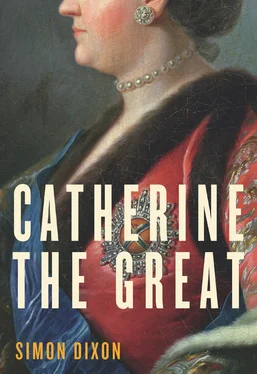In the early 1750s, Russia’s greatest polymath Mikhailo Lomonosov claimed that from the top of any tall building in the capital one could see ‘houses that seemed to float on water and streets laid out in lines as straight as regiments on parade’. 16As if to prove his point, Mikhailo Makhaev spent the late 1740s perched among the city’s bell towers and on top of Tsar Peter’s Kunstkamera , sketching with the assistance of a large optical ‘camera’. The machine’s wide-angled lens combined with the artist’s elevated viewpoint to distort the perspective in such a way that his famous engravings are dominated by the space between buildings rather than by the buildings themselves. 17But that is not to underestimate the extent to which St Petersburg was transformed in Elizabeth’s reign ‘from a Europeanized riverfront backed by thousands of native hovels into a Western metropolis’. 18In a conscious attempt to legitimise her seizure of the throne, the grandest Baroque edifices were built to mark the route she had taken on that fateful night in November 1741. 19Indeed, so rapidly had those events acquired mythical status, that shortly after her arrival in February 1744, Johanna Elisabeth was taken to retrace the empress’s steps, starting from ‘the famous barracks of the Preobrazhensky Guards’ where Elizabeth had already laid the foundation stone of a magnificent new cathedral of the Transfiguration. ‘It is incomprehensible that Her Majesty should have managed such a long march without being betrayed.’ 20
* * *
Since Tsar Peter had intended his new capital to stand as an icon of Russia’s aspirations to sophisticated cosmopolitanism, it is all the more striking that the entertainment laid on for fourteen-year-old Princess Sophie should have been unashamedly exotic and emphatically popular. After dinner at the Winter Palace, she was treated to a display by the fourteen elephants which had become familiar figures on the capital’s streets following their presentation to Empress Anna by a visiting Turkish embassy. One of the animals on that occasion was said to be draped in King Solomon’s tent, a characteristically extravagant notion duly dismissed by Dr Cook: ‘It was of silk, very large, and certainly the worse of the wearing, but I scarcely believe it was Solomon’s.’ Not long afterwards, a bystander lost his life when two beasts bolted from soldiers who had thrown fireworks at their feet in an attempt to make them fight in the snow. 21Fortunately for her hosts, the show staged in Sophie’s honour passed off without incident. Once the elephants had completed their stately pirouettes in the palace courtyard, she was taken out onto the frozen river to see the ice hills that were a prominent feature of the capital at carnival time. 22
By the time the last of Anna’s elephants died in 1765, the elephant house had long been moved from its central location on the Fontanka Canal to a suburban site near the Alexander Nevsky monastery. 23Ice hills, however, remained popular throughout Catherine’s reign, attracting vast crowds of spectators to watch as intrepid revellers descended precipitous slopes at great speed, either upright on skates or seated on wooden trays. She adored the one at Gostilitsy—the suburban estate belonging to Elizabeth’s favourite, Aleksey Razumovsky, where the Russian Court regularly paid a visit halfway through Lent—and in 1762 she had Antonio Rinaldi build her own all-weather tobogganing pavilion at the Summer Palace at Oranienbaum, a fantasy of powder-blue and white. 24
It consists of steep declivities built of timber, the highest end being ten fathoms above the ground, and borne up on an arch. The impetus acquired by rapidly descending the first forces the carriage up the second, which having turned it is carried up a third and so proceeds in diminishing altitudes, with amazing velocity. The carriages are made to contain one person, or two seated facing one another, the wheels running in grooves. 25
A less extravagant wooden sleigh-run at Tsarskoye Selo was demolished in 1777 to make way for a merry-go-round. Even in the last years of her life, Catherine liked to take visitors to play on the ice hills near the Tauride Palace she had built for Potëmkin, where she treated the local populace and donated money to their other entertainments. 26
In 1744, such pleasures lay in the future, for no sooner had Sophie arrived in St Petersburg than she was whisked off to Moscow, where the Court was in residence and where Elizabeth expected her in time to celebrate Grand Duke Peter’s sixteenth birthday on 10 February. Improved in Catherine’s own reign by a series of costly schemes, the highway between the two capitals remained in 1744 in much the same state as other Russian roads—a primitive track, constructed from tree-trunks covered with gravel and sand, and passable at speed only when frozen. While it might take the empress’s humbler subjects several weeks to complete the 370-mile journey, she herself could cover the distance in a little over three days by racing through the night and changing horses every twelve or fifteen miles. That January, she had spent forty-nine hours on the road and another twenty-six at staging posts along the way. 27Even Elizabeth had come to regard the price of such speed as prohibitive. When the officer charged with removing snowdrifts, branches and tree stumps from the relatively short section of road between Chudov and Novgorod requested another 1600 men to assist the 400 already assigned to him, he was ordered to dismiss the whole detachment as the decree went out making the owner of each property along the road responsible for clearing it in the following spring. 28Sophie’s entourage encountered a different problem. Shortly after their departure, her mother’s sleigh hit a building while cornering too fast in the dark, injuring a sentry and catapulting the driver from his seat. While Johanna Elisabeth described the incident in typically purple prose, implying that they had all had a brush with death, Catherine’s memoir was cooler: ‘She claimed that she had been grievously injured, though nothing could be seen, not even a bruise.’ Nevertheless, they were delayed for several hours, and it was not until the afternoon of 9 February that they approached the outskirts of the old capital to be escorted to the palace at Lefortovo on the Yauza River, not far from the island where relatives of the young Peter I had created a fortress for his play regiments as a way of mobilising support for his candidature for the throne in the 1680s. 29
Had it been summer, Sophie and her mother would have been greeted by ‘rows of clipped yew-trees, long straight canals’ and what her own generation, fond of less formal layouts, would dismiss as ‘a profusion of preposterous statues’: ‘every little structure was a pantheon; and every grove was haunted by its Apollos and Dianas’. 30For the moment, however, the gardens on which Empress Anna had lavished such careful attention were deep in snow, and the Court was resident not in Rastrelli’s Summer Palace but at the nearby Winter Annenhof (re-christened the Golovin Palace by imperial decree on 29 February) on the other side of the Yauza. 31This ornate wooden structure had been transferred in its entirety from the Kremlin in 1736 before being enlarged and embellished six years later in preparation for Elizabeth’s coronation. Its interiors were brightly painted in green, yellow and blue—all typical colours for Russian palaces in the first half of the eighteenth century. 32
Having met the new arrivals at the foot of the ceremonial staircase, Field Marshal the Prince of Hesse-Homburg, a leading member of the pro-Prussian party at Court, offered his arm to Johanna Elisabeth and led them to their apartments. There they were joined by the household of Grand Duke Peter, who apparently burst in on Sophie’s mother as she was loosening her head-dress. A little before 10 p.m., another anti-Austrian schemer, the empress’s surgeon Armand Lestocq, announced that the empress was ready to receive them. Having been presented to the ladies-and gentlemen-in-waiting in the crowded ante-chamber, where Johanna Elisabeth was conscious of being scrutinised ‘from head to toe’, they processed through the state apartments to the audience chamber, where the thirty-five-year-old empress appeared before them on the threshold of her state bedroom.
Читать дальше












